U.S. Review
Hard Data Still Not as Spectacular as Survey Data
- Hard data from the U.S. housing market and durable goods orders from U.S. factories in February were mixed. Though readings were more muted than recent sentiment indicators, the hard data continue to point to a positive underlying trend.
- Existing home sales fell slightly in February, from January’s strong read, but resales are still off to a strong start for the year. New home sales were boosted by warmer weather in February, pulling up the spring home buying season.
- Durable goods orders posted a gain in February, which was to be expected given the strong survey reads, but details were lackluster.
Housing Demand Still High in 2017
New data generally show a strong start to the year for the housing market. After January’s cycle-high pace of existing home sales, contract closings dipped in February to a 5.48-million unit pace. This was somewhat expected as pending home sales, which are counted when a contract is signed and are a leading indicator for existing home sales, declined in January. Low inventory of homes for sale and higher mortgage rates were likely restraining resale activity. On the bright side, February’s dip in resales allowed inventories to rebound slightly, but they remain 6.4 percent lower than the same time last year. There is now a 3.8-month supply of existing homes for sale, much lower than a balanced market, which would have around a 5.5-month supply. Lean inventories make this a sellers’ market, as a typical home sold in February was on the market for just 45 days.
Similarly, now is a good time for home builders. Coinciding with the recent upswing in the NAHB/Wells Fargo Housing Market Index, a measure of builder sentiment, new home sales were up solidly in February. Besting consensus estimates, new home sales rose 6.1 percent in February to a 592,000-unit pace. The month ended with 266,000 new homes available for sale, a 5.4-month supply, which is down from January. Mild weather likely favored activity in the month, pulling the spring selling season forward into February. A correction is likely in coming months. Expectations of rising mortgage rates may have also played a role in the unseasonably strong showing in February. Still, underlying strength in the domestic economy supports housing demand. Job and income growth should continue to bring more potential homebuyers into the market, even as mortgage rates rise. Rising home prices and lean inventory of homes for sale should encourage more home construction going forward.
Still Waiting for Hard Order Data to Jump
Recent readings from the ISM manufacturing and regional Fed surveys of manufacturing activity have jumped much higher since the election. We continue to wait to see that jump reflected in hard data from the manufacturing sector. To be sure, factory data have firmed considerably from the weak patch that stretched from about mid-2014 to mid-2016 as manufacturers struggled with soft global demand, the strong dollar and a downturn in the energy sector. Much of those headwinds are largely fading and incoming data have reflected that. However, the upswing in survey readings we have witnessed since the election has yet to translate into the hard data. Durable goods orders for February bested expectations with a headline increase of 1.7 percent, but the underlying details were unimpressive. Orders of capital goods excluding defense and aircraft, which reflects demand for business investment in goods such as computers and machinery, declined 0.1 percent on the month, surprising forecasters who anticipated a 0.5 percent increase. Shipments in the same category are used to calculate GDP and were up 1.0 percent in February. Still, shipments reflect past activity, orders are what we watch to gauge demand going forward and, so far at least, businesses appear to be waiting to act on the excitement reflected in the survey data.
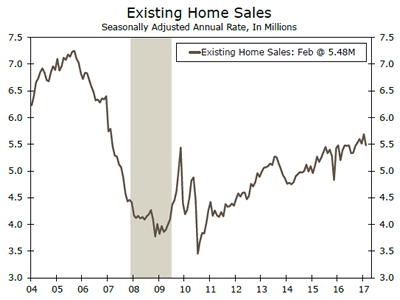
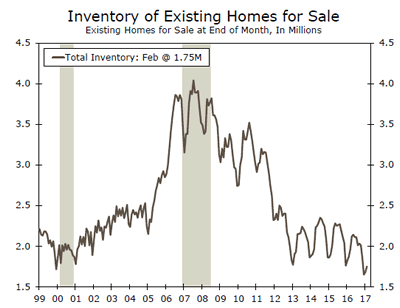
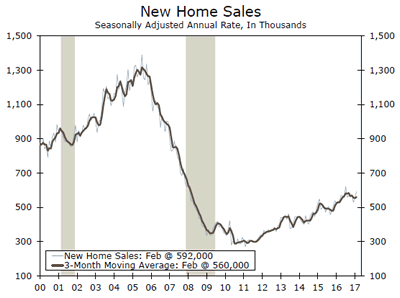
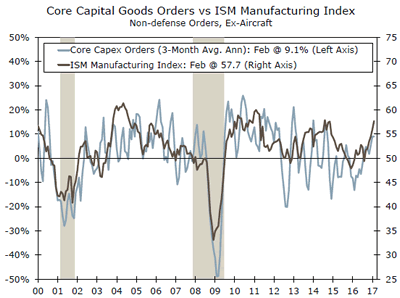
U.S. Outlook
Consumer Confidence • Tuesday
Consumer confidence continued to climb in February, rising 3.2 points to its highest level since July 2001. The present situation index climbed to 133.4, a new cycle-high, while expectations for the future recouped some of January’s dip. Over the past year, views on both the present situation and future economic conditions have risen a sizable 18.4 and 22.5 points, respectively. The S&P 500 has jumped about 10 percent since the election, and home prices continue to rise amid relatively lean inventories. This has likely created a wealth effect which, coupled with the current administration’s focus on economic growth and employment, have spurred much of the gain in consumer confidence.
We expect the consumer confidence index to moderate a bit from its recent highs. The index will likely remain near cycle-highs, however, which suggests some upside potential for the U.S. consumer in the months ahead.
Previous: 114.8 Wells Fargo: 113.1
Consensus: 113.6
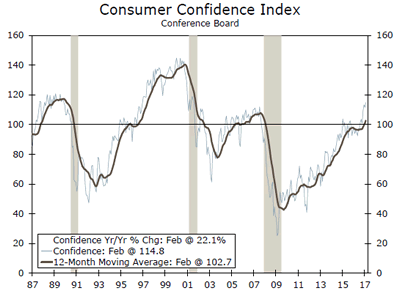
GDP • Thursday
On Thursday we will receive the third look at economic growth in Q4. The initial round of revisions resulted in no change to the headline number, and we expect only minimal changes this time around. As we turn to Q1, economic growth once again looks a bit soft to start the year. Residential construction has been aided by warm weather, and business fixed investment looks likely to continue its gradual recovery. Government spending has been soft, however, and personal consumption looks likely to slow from the pace seen over the past few quarters. In addition, trade seems likely to weigh on growth, and we do not expect inventories to contribute as much as they have of late.
Through the volatility, real final sales to domestic purchasers, a measure of underlying domestic demand, has shown signs of a pick-up, a trend we expect to continue. Thursday’s report also includes the first release of Q4 2016 corporate profits.
Previous: 1.9% Wells Fargo: 2.0%
Consensus: 2.0% (Quarter-over-Quarter Annualized)
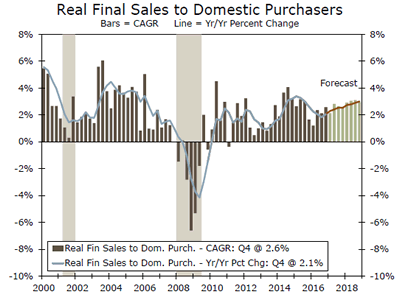
Personal Income & Spending • Friday
Consumer spending started 2017 with a thud, falling 0.3 percent after accounting for inflation. Some of the weakness can likely be attributed to one-off factors, such as lower utilities spending due to unusually warm weather. A slow start to tax refund season in February could lead a one-off factor affecting spending at the margin. It remains to be seen if the robust gains in consumer confidence will translate into acceleration in consumer spending. As of January, the three-month annualized growth in real personal consumption was a trend-like 2.5 percent.
On the inflation front, both the headline and core PCE deflators are near the Fed’s two percent inflation target. We expect inflation to remain firm, but the pace of gains will likely moderate as the base effects from the oil price slide begin to fade later this year. This should allow the Fed to meet its current projections of two more hikes in 2017 without warranting a more rapid pace of tightening.
Previous: 0.2% Wells Fargo: 0.2%
Consensus: 0.2 % (Spending)
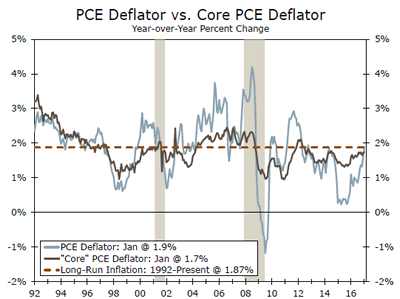
Global Review
MPC: Between a Rock and a Hard Place?
- Real retail spending in the United Kingdom rose more than expected in February. That said, growth in retail spending has clearly downshifted in recent months. Higher inflation, which currently exceeds the Bank of England’s two percent target, is eroding real income growth.
- For now, the Bank of England appears willing to allow inflation to exceed its target for an undisclosed period of time. We believe that the Monetary Policy Committee will refrain from hiking rates through at least the end of the year.
MPC: Between a Rock and a Hard Place?
Economic data that were released this week in the United Kingdom contained both good news and bad news. Let us start with the positive. Real retail spending rose 1.3 percent in February relative to the previous month. Not only did the outturn materially best the consensus forecast, but it more than reversed the 0.3 percent decline that was registered in January.
That said, the pace of retail spending in the United Kingdom has clearly downshifted over the past few months (top chart). If real retail spending in March remains unchanged at February’s level, then spending will have contracted about 1 percent (not annualized) on a sequential basis in the first quarter. In Q4, real spending grew 1.2 percent despite the large decline registered in December. Consequently, spending momentum was weak entering 2017.
The culprit behind the spending slowdown seems to be the rise in inflation in recent months. As shown in the chart on the front page, the overall CPI inflation rate rose to 2.3 percent in February, the highest inflation rate in more than three years. Not only does the rise in the British inflation rate in recent months reflect the rebound in energy prices that has occurred over the past year, but it also reflects the effects of the sterling depreciation that has pushed up import prices. With growth in average weekly earnings remaining more or less constant in recent months (middle chart), the rise in inflation has eroded growth in real disposable income. Consequently, spending growth has slowed.
The simultaneous downshift in economic momentum and the rise in inflation present somewhat of a quandary for the Monetary Policy Committee (MPC) at the Bank of England. Does the MPC ease policy to shore up spending, does it raise rates to fight higher inflation, or does it keep policy on hold pending further developments? For now, the MPC has opted to remain on hold. In the statement that was released after its March 15 policy meeting, the MPC acknowledged that inflation likely will rise to 2-¾percent in coming months, which is well above its 2 percent target, before gradually drifting back toward target. For now, the MPC is willing to allow inflation to exceed its target for an undisclosed period of time. The MPC said that it could tighten policy in coming months if inflation moves even higher than it forecasts. Conversely, it could ease policy further if economic activity slows more than expected. In the meantime, the MPC appears to be in wait-and-see mode.
Prime Minister May is widely expected to formally trigger Article 50 of the Lisbon Treaty next week, thereby starting the two-year negotiating window that the United Kingdom and the European Union have to settle the terms of their divorce. Growth in investment spending has slowed over the past year or so, and a survey of investment "intentions" remains at a low level (right chart). The uncertainty that the Brexit negotiations will engender could weigh on investment spending going forward, giving monetary policymakers another reason to refrain from hiking rates. In our view, the MPC will indeed keep rates on hold through at least the end of this year.
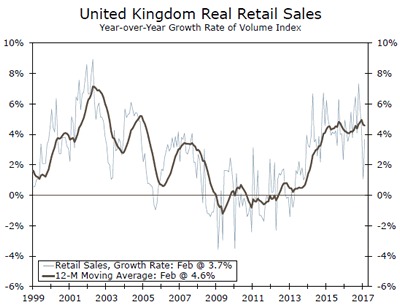
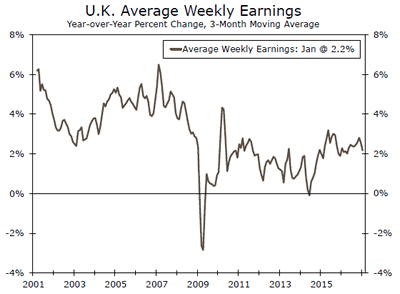
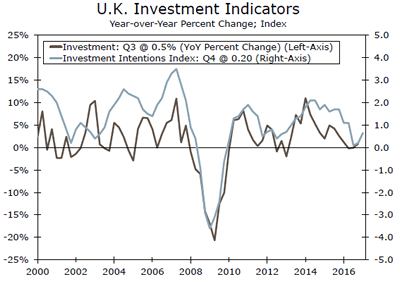
Global Outlook
Germany IFO • Monday
The German IFO business climate and business expectations have remained relatively high and on an upward trend over the past several months, while the IFO current assessment index has seen an important improvement since mid-2016. This tends to indicate that the economic environment has continued to improve and markets should probably expect further improvement for Monday’s release as the health of the global economy continues to improve.
Also on Monday, we will get the release of the retail sales index for February. This index has been very volatile both on a month-over-month basis as well as on a year-over-year basis. Still, it will be important for the domestic economy to see a rebound from the downwardly revised decline of 1.0 percent for January. A sustained improvement in domestic consumer demand will be a good complement to an improving global economy.
Previous: 111.0
Consensus: 111.1 (Business Climate)
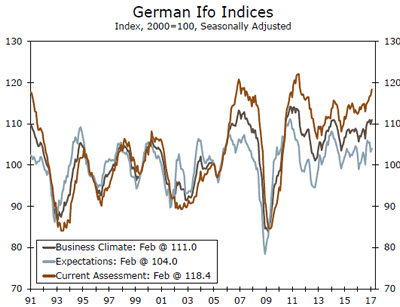
Mexico Economic Activity • Monday
We have a call for a mild recession affecting the Mexican economy this year, and the release of the economic activity index for January will give us a first look at whether this call has a chance of becoming reality. Furthermore, many things happened in the first month of the year that could make the January number look even weaker than what otherwise would have been, like the 20 percent increase in gasoline prices and the ensuing social upheaval and discontent.
On Thursday, the central bank will decide if it continues with its tightening of monetary policy in order to counteract the more than doubling of inflation we are expecting for this year. The Mexican central bank has already increased the target interest rate by 250 basis points since June of 2016 and will probably continue with its higher interest rate campaign in March as it tries to reign in inflationary expectations.
Previous: 2.1%
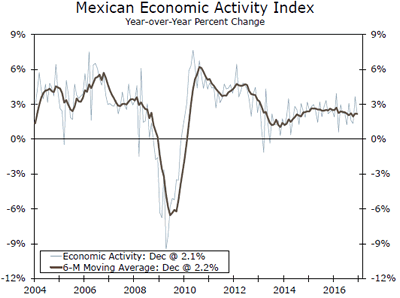
China Manufacturing PMI • Thursday
The world will be looking closely at Thursday’s release of China’s manufacturing PMI for March on Thursday to see if the recent improvement in this index can be sustained. As of this week, markets believe that the index is going to remain at 51.6, which was the reading we had in February.
This manufacturing PMI, released by the National Bureau of Statistics tends to be biased toward manufacturing activity at state-owned enterprises. The Caixin manufacturing PMI index, on the other hand, tends to be biased toward measuring manufacturing activity of foreign owned firms. This index is scheduled to be released early the following week. However, both of these indices have remained above the 50 demarcation point during the past several months, so any improvement by these indices will be good news for the global economy.
Previous: 51.6
Consensus: 51.6
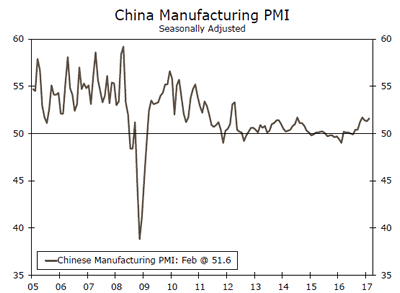
Point of View
Interest Rate Watch
Reality Sinks In
Financial markets pulled back this week, with the S&P 500 ending down and yields for U.S. Treasury maturing two or more years out also slipping. The decline in yields builds on a drop last week that followed a "dovish" hike by the FOMC.
Although comments from Fed officials in the weeks prior to the March meeting signaled that the timing of the first rate hike this year would be moved up, the FOMC left its outlook for the economy and interest rates at year-end virtually unchanged. The stable forecast calmed any fears that the Fed was may ramp up the pace of policy tightening later this year, leading benchmark yields out the curve to decline.
Doubt about the extent of reflation may also be creeping into investors’ minds. Oil prices are down more than 10 percent since the start of the month, while core inflation is rising at an unhurried pace. Short term measures of inflation compensation, derived from 5-year TIPS spreads, fell to their lowest level since early February this week.
The biggest weight on markets this week, however, may be growing signs that the Trump administration could have a tough time getting its policies through Congress. The sharp rise in markets since the election suggests investors have banked on pro-growth policies from the new administration. However, as this week’s showdown on the GOP’s healthcare bill illustrated, unity among the Republican party should not be taken as a given (see Topic of the Week for more on the healthcare bill).
In addition, the time and political capital spent on replacing the Affordable Care Act as the first piece of major legislation from the new administration has pushed out the timing when tax reform is likely to be tackled.
We continue to expect growth and corporate profits to firm this year even in the absence of significant changes in fiscal policy. With growth picking up and the Fed set to hike a couple more times, the pullback in benchmark rates looks temporary, in our view.

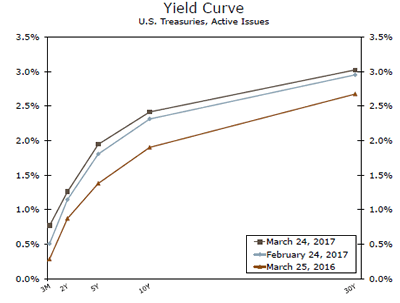

Credit Market Insights
Unmet Consumer Credit Demand
This week, the Federal Reserve Bank of New York published results from its February 2017 Survey of Consumer Expectations (SCE) Credit Access Survey, which offers data on consumers’ experiences and expectations related to credit demand and credit access. The results, which are published on a quarterly basis, reveal that the proportion of "discouraged" consumers rose, while respondents likely to apply for at least one type of credit over the next 12 months decreased. Credit application rates fell to 39.9 percent from 42.3 percent in October, the lowest rate since the series’ inception in 2013. However, credit rejection rates also declined to 21.2 percent from 23.3 percent.
With regard to consumer expectations, respondents who reported that they are likely to apply for at least one type of credit over the next 12 months declined to 26.0 percent from 27.8 percent. Likewise, the expectation of having a credit application rejected rose. Mortgage applications displayed the most pronounced increase in this category, rising to 41.4 percent from 34.2 percent.
Despite the generally subdued outlook for credit expectations, the financial fragility metrics of U.S. households seemed to exhibit some optimism. The average probability of needing $2,000 for an unexpected expense in the next month was 32.5 percent, down from 34.1 percent. Moreover, the likelihood of coming up with $2,000 rose to 67.2 percent from 65.9 percent.
Topic of the Week
ACA Replacement Bill Still in Limbo
At the time of this publication, the long awaited replacement bill for the Affordable Care Act (ACA) is still pending. Known as the American Health Care Act, the proposed bill eliminates a number of tax provisions used to fund the ACA and jettisons the individual and employer mandates. The major reforms to the ACA include transforming Medicaid into a per capita allotment, expanding health savings accounts and providing a monthly tax credit for individuals to purchase insurance. On net, the analysis from the Joint Committee on Taxation (JCT) and the Congressional Budget Office (CBO) shows that the bill will reduce the federal deficit by $337 billion over the 2017-2026 period (CBO’s "The American Health Care Act Cost Estimate," Mar. 2017). In the short-run, however, the immediate repeal of ACA-related taxes and the delay in Medicaid cuts would lead to an increase in the deficit, a factor already incorporated into our baseline deficit forecast.
The number of uninsured, relative to current law, is expected to increase by 14 million in 2018 and rise to 24 million by 2026 as more individuals opt out of purchasing insurance after the removal of the individual mandate. We expect a one or two quarter downshift in the pace of real consumer spending growth as individuals choose to cancel insurance coverage; however, this effect is likely too minimal on our baseline forecast. Higher insurance premiums for those remaining insured have the potential to crowd out other forms of consumer spending on the margin in 2018 and 2019. Besides the divisions within the Republican party likely resulting in potential amendments to the bill, there are procedural hurdles that need to be cleared before votes are taken in the Senate. With differing views on the bill between the House and Senate, there is likely to be a conference committee between the two chambers, further drawing out the legislative process. Our view is that this will likely push the debate over tax reform until after the August recess.















